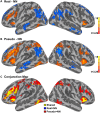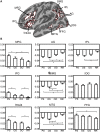The Neural Correlates of the Interaction between Semantic and Phonological Processing for Chinese Character Reading
- PMID: 27445914
- PMCID: PMC4917538
- DOI: 10.3389/fpsyg.2016.00947
The Neural Correlates of the Interaction between Semantic and Phonological Processing for Chinese Character Reading
Abstract
Visual word recognition involves mappings among orthographic, phonological, and semantic codes. In alphabetic languages, it is hard to disentangle the effects of these codes, because orthographically well-formed words are typically pronounceable, confounding orthographic and phonological processes, and orthographic cues to meaning are rare, and where they occur are morphological, confounding orthographic and semantic processes. In Chinese character recognition, it is possible to explore orthography to phonology (O-P) and orthography to semantics (O-S) processes independently by taking advantage of the distinct phonetic and semantic components in Chinese phonograms. We analyzed data from an fMRI experiment using lexical decision for Chinese characters to explore the sensitivity of areas associated with character recognition to orthographic, phonological, and semantic processing. First, a correlation approach was used to identify regions associated with reaction time, frequency, consistency and visual complexity. Then, these ROIs were examined for their responses to stimuli with different types of information available. These results revealed two neural pathways, one for O-S processing relying on left middle temporal gyrus and angular gyrus, and the other for O-P processing relying on inferior frontal gyrus and insula. The two neural routes form a shared neural network both for real and pseudo-characters, and their cooperative division of labor reflects the neural basis for processing different types of characters. Results are broadly consistent with findings from alphabetic languages, as predicted by reading models that assume the same general architecture for logographic and alphabetic scripts.
Keywords: Chinese; connectionist model; fMRI; stimulus correlation approach; visual word reading.
Figures




Similar articles
-
A meta-analysis of fMRI studies on Chinese orthographic, phonological, and semantic processing.Neuroimage. 2012 Oct 15;63(1):381-91. doi: 10.1016/j.neuroimage.2012.06.047. Epub 2012 Jul 1. Neuroimage. 2012. PMID: 22759996 Review.
-
Electrophysiological evidence of sublexical phonological access in character processing by L2 Chinese learners of L1 alphabetic scripts.Cogn Affect Behav Neurosci. 2016 Apr;16(2):339-52. doi: 10.3758/s13415-015-0394-z. Cogn Affect Behav Neurosci. 2016. PMID: 26620688
-
Orthographic learning via self-teaching in Chinese: The roles of phonological recoding, context, and phonetic and semantic radicals.J Exp Child Psychol. 2020 Nov;199:104913. doi: 10.1016/j.jecp.2020.104913. Epub 2020 Jul 16. J Exp Child Psychol. 2020. PMID: 32683144
-
Comparison of brain mechanisms underlying the processing of Chinese characters and pseudo-characters: an event-related potential study.Int J Psychol. 2010 Apr 1;45(2):102-10. doi: 10.1080/00207590903156439. Int J Psychol. 2010. PMID: 22043890
-
Measuring orthographic transparency and morphological-syllabic complexity in alphabetic orthographies: a narrative review.Read Writ. 2017;30(8):1617-1638. doi: 10.1007/s11145-017-9741-5. Epub 2017 Apr 17. Read Writ. 2017. PMID: 28932018 Free PMC article. Review.
Cited by
-
Reading Braille by Touch Recruits Posterior Parietal Cortex.J Cogn Neurosci. 2023 Oct 1;35(10):1593-1616. doi: 10.1162/jocn_a_02041. J Cogn Neurosci. 2023. PMID: 37584592 Free PMC article.
-
Correlation Between Speech Repetition Function and the Arcuate Fasciculus in the Dominant Hemisphere Detected by Diffusion Tensor Imaging Tractography in Stroke Patients with Aphasia.Med Sci Monit. 2020 Dec 5;26:e928702. doi: 10.12659/MSM.928702. Med Sci Monit. 2020. PMID: 33277460 Free PMC article.
-
The Interaction Between Phonological and Semantic Processing in Reading Chinese Characters.Front Psychol. 2019 Jan 10;9:2748. doi: 10.3389/fpsyg.2018.02748. eCollection 2018. Front Psychol. 2019. PMID: 30687194 Free PMC article.
-
Spatiotemporal Neural Network for Sublexical Information Processing: An Intracranial SEEG Study.J Neurosci. 2024 Nov 6;44(45):e0717242024. doi: 10.1523/JNEUROSCI.0717-24.2024. J Neurosci. 2024. PMID: 39214706 Free PMC article.
-
Left and Right Arcuate Fasciculi Are Uniquely Related to Word Reading Skills in Chinese-English Bilingual Children.Neurobiol Lang (Camb). 2022 Feb 10;3(1):109-131. doi: 10.1162/nol_a_00051. eCollection 2022. Neurobiol Lang (Camb). 2022. PMID: 37215330 Free PMC article.
References
Grants and funding
LinkOut - more resources
Full Text Sources
Other Literature Sources
Miscellaneous

